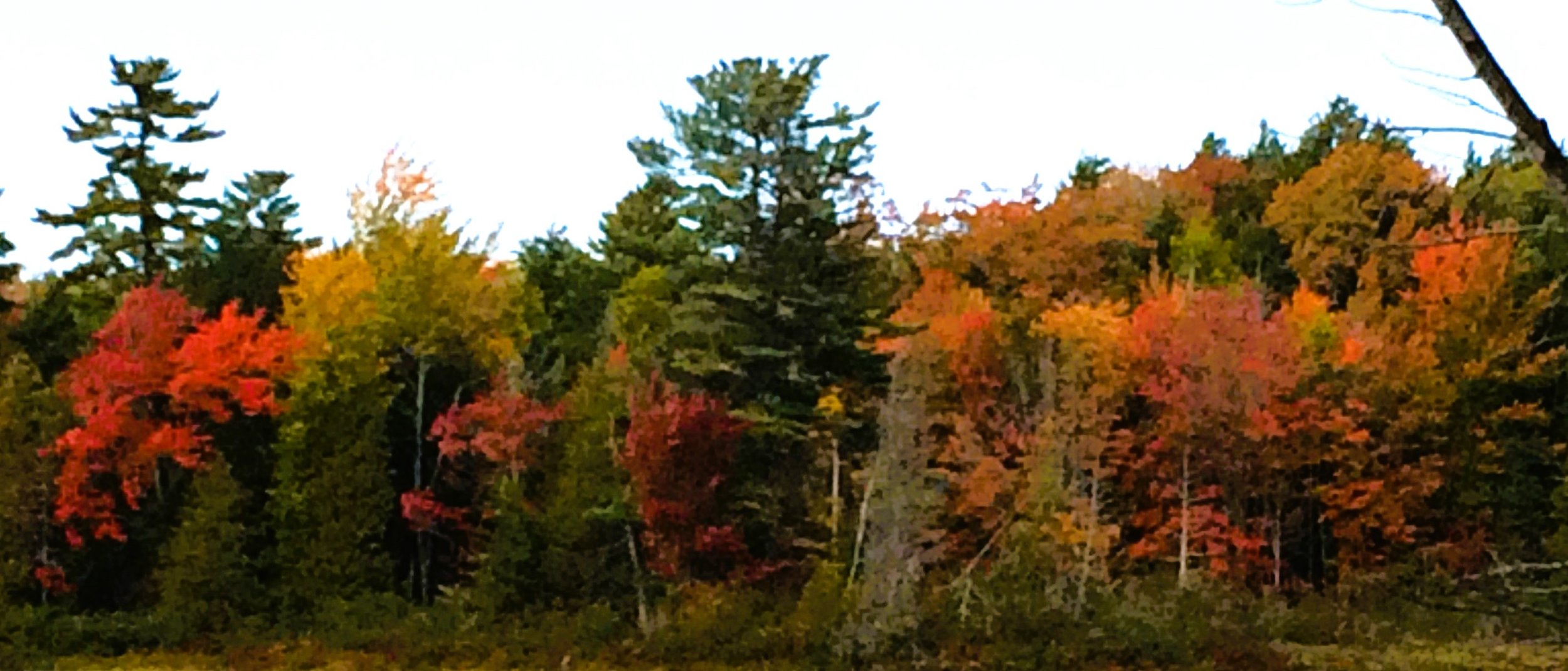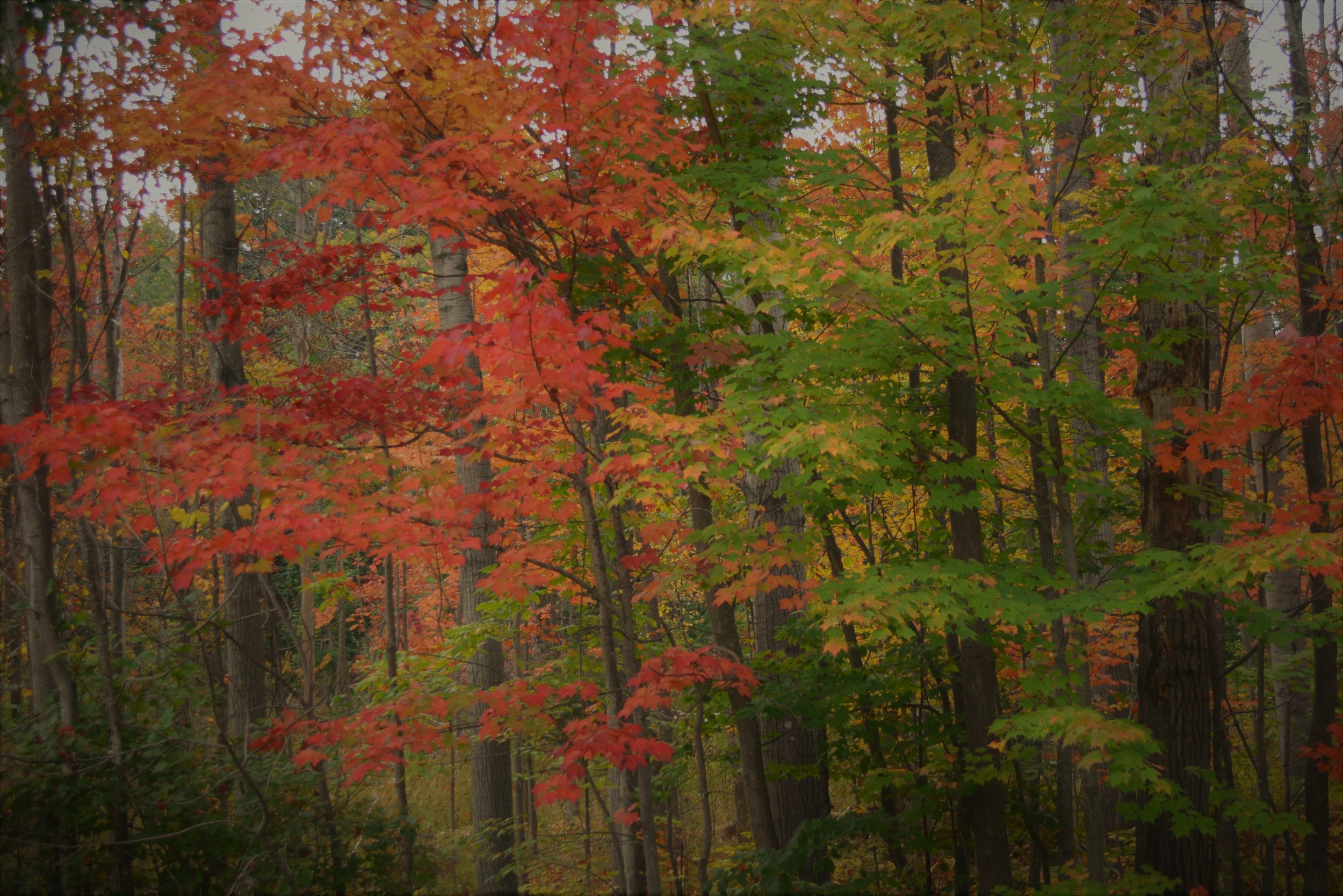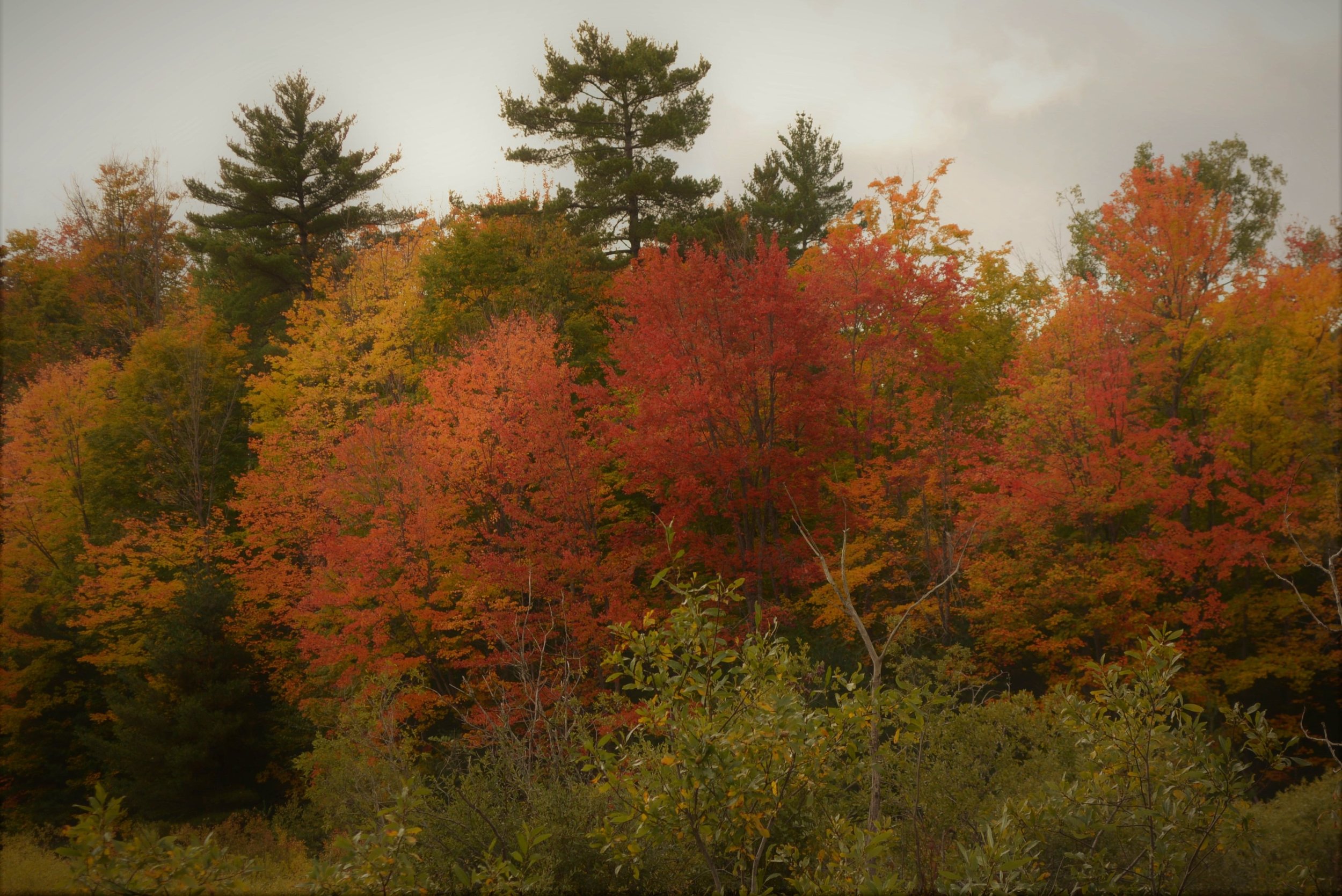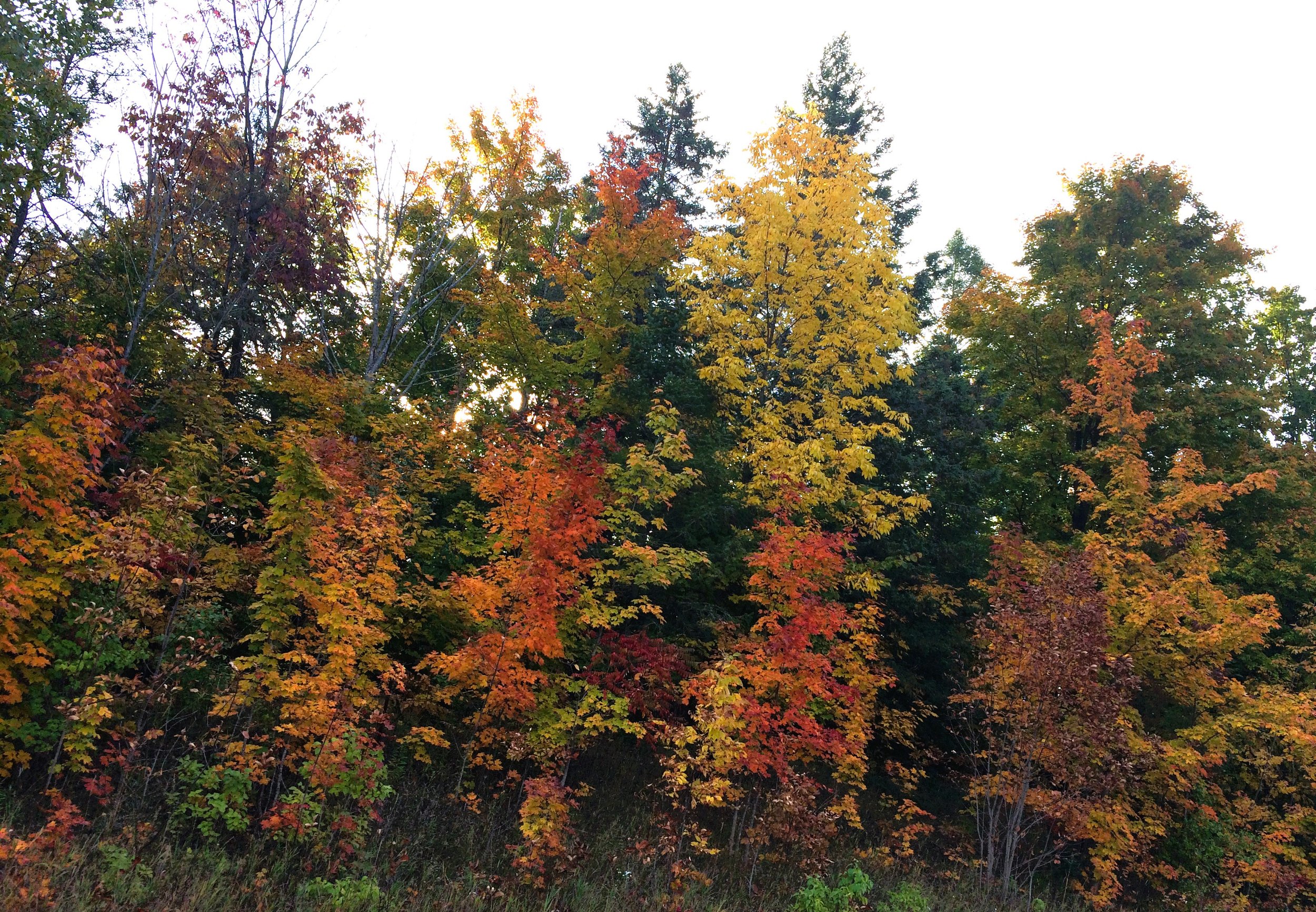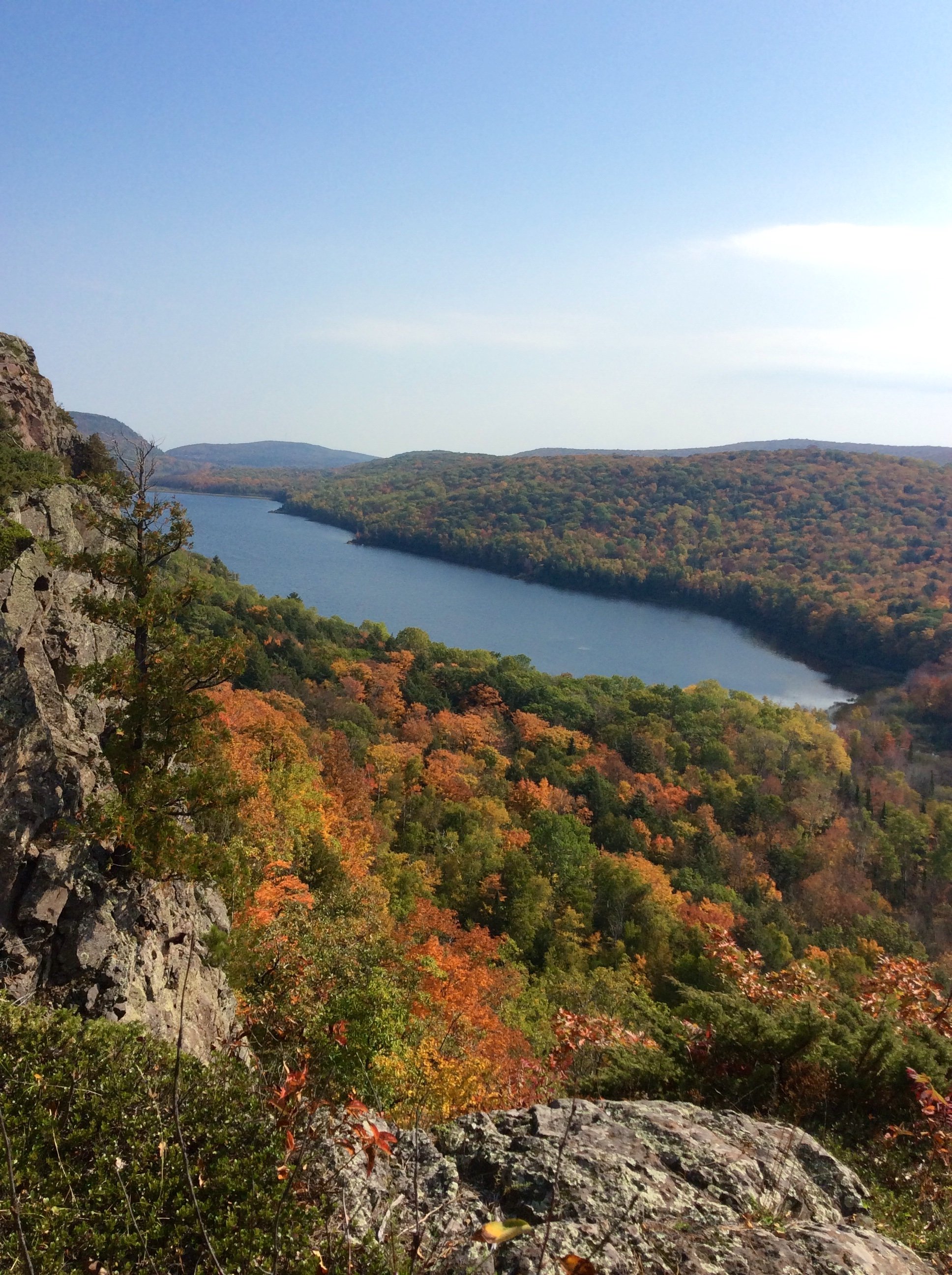At some point on my drive, I realized that I was so enraptured by the beauty all around me that I had stopped breathing. The trees were breathtaking. Not a mere figure of speech, this must be where the term originated – that one’s breath is literally taken when overwhelmed by beauty. From a somatic perspective, one’s breath and heart rate slow as the parasympathetic nervous system is activated. Perhaps I was in a place of such perfect peace and calm that I barely needed to breathe.
In recent years, I’ve often driven the length of Michigan’s Upper Peninsula, a mostly hidden gem of autumnal glory, during peak color season. The trees along the roadside are a perfectly balanced artist’s array of scarlets, ambers, golds, oranges, greens, and browns. At various points along the way lush expanses of the Porcupine and Huron mountains emerge in full color as does the deep blue of Lake Superior. It is a total immersion experience that unfolds every mile for eight continuous hours.
As I drive, I listen to music as exquisite as the leaves -- my mother’s favorite album — Great Performances of The New York Philharmonic conducted by Leonard Bernstein: Ralph Vaughn Williams’ Fantasia on a Theme by Thomas Tallis and Fantasia on Greensleeves, Tchaikovsky’s String Quartet No. 1 in D Major, Mahler’s Symphony No. 5 in C Sharp Minor, and Barber’s Adagio for Strings. The Adagio was my mother’s favorite for the way it causes the soul to leap in an exquisite arc of melody. Whenever it was playing on the hi-fi, she would drop whatever she was doing, come find us and make us stop and listen as the strings soared to what seemed to be the pinnacle. We would hold our breath in anticipation as they climbed yet again higher, lingering long, and then exhale as they descended to their denouement. Breathtaking.
The harmonies of hues and tones carry me along as I drive by vivid vistas and lazuline lakes. As I make the turn high above Munising, a small harbor town surrounded by high hills on three sides and Lake Superior on the other, I find myself near tears so overcome am I by the splendor. The hills surrounding the town are ablaze in color, contrasting with the deep blue of Lake Superior. Enveloped and enraptured, I am overcome with gratitude. It was here several years before that I had discovered the capacity of beauty to heal.
That year I was on sabbatical to complete work on a book. It was also a needed time away from years of being embroiled in academic politics. With ever-increasing budget cuts, morale at our university was low. Our department of Women’s Studies had always had to fight for our existence, but this last had been an especially difficult year. The battles, callousness, and pettiness had sucked the life out of me and I’d grown cynical and hard. I hardly recognized myself. I didn’t like who I’d become, and feared that I was forever changed.
Lake of the Clouds, Porcupine Mountains
But that fall, as I first made that drive across the UP with my dog, Charlie, with each passing mile I could feel the crustiness fall away. We stopped for a hike in the Porcupine Mountains and drove that gorgeous stretch of road along Lake Superior from the Porkies to Ontonagon before turning inland through the Ottawa National Forest where we were blanketed in all possible shades of greens, golds, yellows, reds, burgundies, and bright oranges. By the time I made that turn into Munising, I was weeping not only from the sheer beauty, but from realizing that the hard core of cynicism that had encased my spirit was gone, and that I had come back to myself, a self that knew a capacity for goodness, joy, and deep gratitude.
In the years of suffering from cardiomyopathy before my heart transplant, I had tried all varieties of self-healing techniques and knew well the healing capacities of various colors. [i] Red induces vitality and counters depression. Yellow is cheering. The deep blue of sky and sea calms the body and soul, and can even reduce blood pressure and heart rate. Both green and orange are especially noted for their healing qualities —stimulating growth, renewal, joy, and happiness. Perhaps I’d simply immersed myself in hours of color therapy, but this felt deeper, a metanoia, a true change of heart.
I had begun that particular drive by re-listening to an On Being podcast of Krista Tippett’s interview with Robin Wall Kimmerer that I had first heard earlier that year on MPR. I had been captivated by Kimmerer, and her braiding together of indigenous wisdom with scientific knowledge. I was particularly drawn to her fascination with beauty, an intrigue I shared. I’d wondered often about beauty and its relation to truth, goodness, and justice. I found myself pondering beauty as I drove, unaware until that moment in Munising that I was, as Rilke suggested, living the question, and that “gradually, without even noticing it,” I had lived my way into the answer.[ii]
I’ve made this trip almost every year since that time, an important soul renewal in a world that has grown increasingly harsh with hate-filled politics, war, gun violence, racial strife, a stripping away of the rights of women and LGBTQ folk, a global pandemic, and a quickly degrading climate. This time I interspersed the music with an audio version of Kimmerer reading her Braiding Sweetgrass, her lilting voice music in and of itself. Though I’ve read the book three or four times, listening to her read it, I heard details I’ve never heard before.
I was particularly taken this time by her retelling of the indigenous creation story of Skywoman, who fell to the earth “on an autumn breeze,” (3), her fall eased by a flock of geese who gently carried her downward, where a great turtle offered his back upon which to rest. The other animals gathered to bring mud from the bottom of the waters to create a home for Skywoman on land. Many ventured but failed, till only muskrat was left. He dove deep, and after a very long time his limp body surfaced, still clutching a handful of mud in his paw. He had given his life so that Skywoman might live. Skywoman was so moved that she sang and danced in thanksgiving, and the land grew. On her way down, she had fleetingly grabbed onto the Tree of Life, and so had brought with her the seeds of all kinds of plants that grew there. As she danced, she scattered these on the ground where they grew into bountiful gardens.
What most struck me in hearing this tale again was Kimmerer contrasting Skywoman’s story with the other “woman in the garden creation story,” that of Eve – the one revered as “the cocreator of the good green world that would become the home of her descendants,” the other reviled, “an exile, just passing through. . . to her real home in heaven” (7). How different might our treatment of the earth, and of women, be if we were raised with the cosmology of Skywoman, who created a garden of grasses, fruits, trees, and medicines “for the well-being of all” (5), rather than that of Eve, banished for tasting the fruit of the garden and commanded to subdue the earth. How different if we were to regard life on this earth not as an exile, but rather our true home; if we regarded the flora and fauna, the minerals and waters not as resources, ours for the taking, but rather as gifts born of gratitude and mutual respect; if we lived in awe of the beauty all around us and began each day in gratitude for the earth and its gifts. We might truly live out the entwining of beauty, goodness, justice, and joy.
Kimmerer prefaces her book by describing sweetgrass -- wiingaashk -- as “the sweet-smelling hair of Mother Earth” (ix). Years ago, driving the back roads of northern Michigan with the windows down, when she would catch a whiff, my mother would pull over and have us breathe it in. “Can you smell it?” she’d ask. For her, it was the sweetest smell in all the earth. “Breathe it in,” my mother would say. “Breathe it in,” Kimmerer continues, “and you start to remember things you didn’t know you’d forgotten” (ix).
Whether breathing in the sweetness of the earth or ceasing to breathe at all so absorbed in its beauty, we begin to remember what we have forgotten – that all of life is a gift to which we owe reciprocity, that in gratitude and appreciation for these gifts we find healing, and that in all beings lives the capacity for goodness and joy, harmony and mutual regard. The reminder of this true knowing is indeed breathtaking.
Sources
Kimmerer, Robin Wall. Braiding Sweetgrass: Indigenous Wisdom, Scientific Knowledge, and the Teachings of Plants. Minneapolis: Milkweed, 2013.
Rilke, Rainer Maria. Letters to a Young Poet. M.D. Herter, trans. Rev. ed. New York: Norton, 1954.
[i] 7 Best Colors For Healing - Color Meanings (color-meanings.com)
[ii] Rilke, Rainer Maria. Letters to a Young Poet. 35. The full quote is, “. . . be patient toward all that is unsolved in your heart and try to love the questions themselves . . . Do not now seek the answers, which cannot be given you because you would not be able to live them. And the point is, to live everything. Live the questions now. Perhaps you will then gradually, without noticing it, live along some distant day into the answer.”
